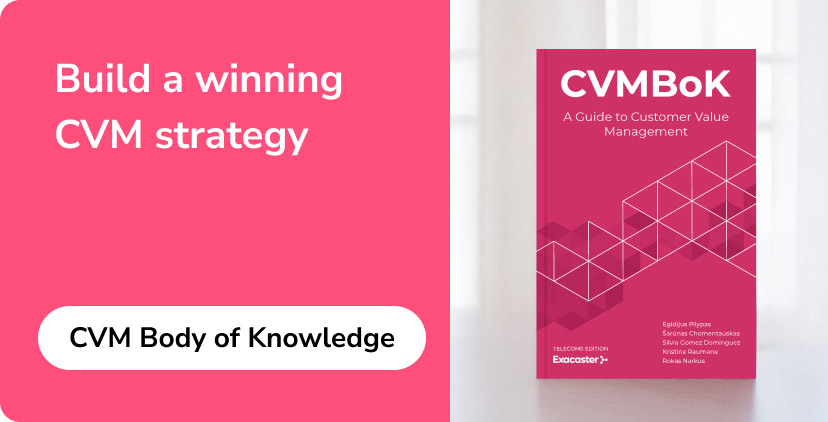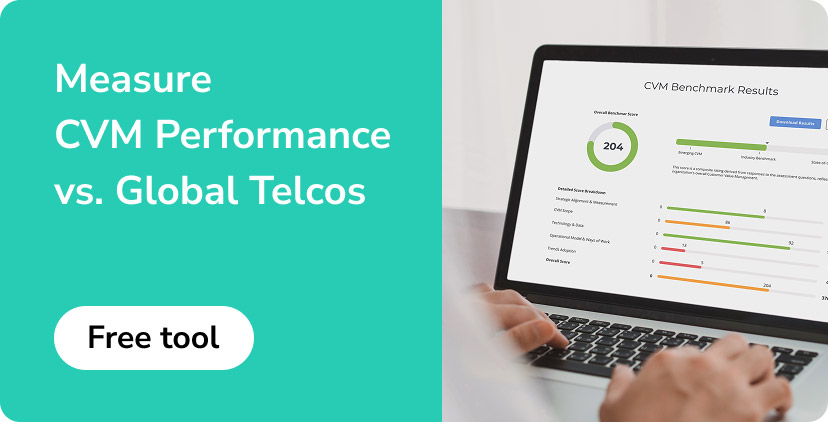Customer value management plays a pivotal commercial role in telecoms, aiming to drive significant business impact. To measure this impact effectively, focus on three primary categories of KPIs, with an optional fourth related to operational efficiency:
- Revenue and profitability: Metrics such as total revenue from the customer base, ARPU, and profitability per customer (not product or service) provide immediate insights into the financial health of the organization.
- Customer base size and retention: Indicators like customer base size, churn rates, and product onboarding rates highlight the stability and growth potential of your customer base as well as product penetration within the customer base.
- CX: Metrics such as net NPS and customer satisfaction score (CSAT) assess the quality of customer interactions and the likelihood of customers recommending your services.
- Operational efficiency: Metrics related to the agility and effectiveness of internal processes, such as the time and effort required to launch and maintain all of your campaigns, offers, and the associated salary, technology, and many other categories of costs.
Balancing these KPIs is crucial for sustainable growth. While revenue and profitability show immediate financial performance, focusing solely on them can be shortsighted. Without considering customer retention and experience, gains in revenue may be undermined by high churn rates later. For example, aggressively promoting upsells without regard for customer satisfaction might boost short-term revenue but lead to long-term customer loss.
Customer retention metrics emphasize the importance of keeping existing customers engaged and satisfied. Retaining customers is often more cost-effective than acquiring new ones. A telecom monitoring churn rates closely can implement targeted retention campaigns, such as offering personalized discounts or proactively fixing the issues that cause customers to leave.
CX metrics like NPS and CSAT provide insights into how customers perceive your services. A high NPS indicates strong customer advocacy, which can lead to organic growth through referrals. For example, improving network reliability might increase customer satisfaction scores, leading to higher retention rates.
Operational efficiency metrics, though sometimes overlooked, are critical for enhancing your responsiveness to market changes and customer needs. Think of it as how much time the CVM team spends on strategic growth opportunities versus the time they spend on operational issues. Streamlining the time it takes to develop and launch new campaigns gives the organization a competitive edge. By automating campaign management processes, you can reduce time-to-market and swiftly respond to competitor moves.
Using CLV as a unifying metric helps integrate revenue, retention, and CX areas. CLV estimates the total net profit expected from a customer over their entire relationship with you. By focusing on CLV, you align short-term financial goals with long-term customer loyalty and satisfaction.
As Marek Wiktor Grabowski, B2C Customer Value Management Director at Orange Poland, emphasizes:

The ultimate KPI is the revenue from the customer base, comprising existing customer purchases, new purchases, and increased value by adding additional services. You need to work on the entire base; that is the scope of CVM.
Measuring the effects of your CVM initiatives is essential for success. Marek adds:

We have introduced a universal control group of customers not touched proactively. We compare CVM results versus that group. Control groups per specific campaigns are also useful to gain insights.
Silvia Gomez Dominguez, Senior Director, Customer Solutions, highlights the importance of aligning KPIs across the organization:

It is important that each part of the business has specific KPIs, but overall, we are all trying to be customer-centric. That way, we’ll be able to achieve customer metrics like NPS, financial metrics like lifetime value, CapEx targets, ROI—all of those.
Elchin Gulmammadov, Group Marketing Director at Azerconnect Group, stresses the need to focus on key inputs:

We are tracking our active customers daily. This is one of the key KPIs for our CVM team because these customers bring revenue. Revenue is the result; we keep our eyes closely on the key inputs because revenue is the output.
He also advocates for keeping the number of KPIs manageable:

I believe in keeping a minimum number of KPIs so that everyone can focus and improve on those. For my team, we keep a maximum of three KPIs per team or division
In practice, CVM professionals must navigate the interplay among these metrics to drive sustainable growth. Overemphasizing revenue might erode customer satisfaction, leading to higher churn. Conversely, focusing solely on CX without regard to profitability may not be sustainable either.
By using CLV as the guiding metric, you can balance these priorities effectively. This approach ensures that your strategies not only drive immediate financial results but also build long-term customer relationships, leading to sustained profitability and a stronger position in the telecom industry.
Previous: The Customer Value Management Role Within the Organization
Next: Selecting the Right Talent: The Key to Customer Value Management Success





